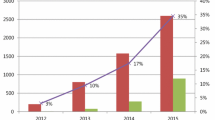Abstract
Despite the rapid development of peer-to-peer (P2P) lending in the world, massive Chinese P2P platforms have failed due to moral risk and liquidity risk, which decreased investors’ confidence in P2P lending. A major question facing the future growth and development of P2P platforms is how to best build investors’ trust. This study was based on the elaboration likelihood model and examines how to persuade investors to develop initial trust in P2P platform. The empirical analysis data were collected from 70 Chinese P2P platforms. The multiple linear regression results support central route variables: the financial and credit status of P2P platforms are key elements in building the trust of investors and impacting their decisions. The subordinate route variables including social capital, risk management, and operating duration provide the necessary support to increase the number of platform investors. The relationship between the average interest rate and number of investors is not linear but exhibits an inverted U-shaped curve. The disclosure of information by the borrowers does not significantly affect the number of platform investors. These findings are an important complement to existing research and will facilitate future development efforts for P2P lending and the rational investments of investors.












Similar content being viewed by others
References
Alexander, B., Alexander, B., Daniel, B., et al. (2011). Online peer-to-peer lending—A literature review. Journal of Internet Banking & Commerce, 16(2), 1–18.
Klafft, M. Peer to peer lending: Auctioning microcredits over the internet. In Proceedings of the 2008 international conference on information systems, technology and management (pp. 1–8).
Emekter, R., Tu, Y., Jirasakuldech, B., et al. (2015). Evaluating credit risk and loan performance in online peer-to-peer (P2P) lending. Applied Economics, 47(1), 54–70.
Barasinska, N. (2009). The role of gender in lending business: Evidence from an online market for peer-to-peer lending. The New York Times.
Ravina, E. (2008). Beauty, personal characteristics, and trust in credit markets. American Law & Economics Association Papers, 67, 1–76.
Pope, D. G., & Sydnor, J. R. (2011). What’s in a picture? Evidence of discrimination from prosper.com. Journal of Human Resources, 46(1), 53–92.
Jeremy, M. (2012). Do unverifiable disclosures matter? Evidence from peer-to-peer lending. American Accounting Association, 87(4), 1385–1413.
Lin, M., Prabhala, N. R., & Viswanathan, S. (2013). Judging borrowers by the company they keep: Friendship networks and information asymmetry in online peer-to-peer lending. Management Science, 59(1), 17–35.
Berger, S. C., & Fabian, G. (2009). Emergence of financial intermediaries in electronic markets: The case of online P2P lending. Business Research, 2(1), 39–65.
Hart, P., & Saunders, C. (1997). Power and trust: Critical factors in the adoption and use of electronic data interchange. Organizational Science, 8(1), 23–42.
Harrison, D. M., & Chervany, N. L. (2001). What trust means in E-commerce customer relationships: An interdisciplinary conceptual typology. International Journal of Electronic Commerce, 6(2), 35–39.
Garner, K., & Deutsch, M. (1974). Cooperative behavior in dyads. Journal of Conflict Resolution, 18(4), 634–645.
Harrison, D. M., Vivek, C., & Charles, K. (2002). Developing and validating trust measures for E-commerce: An integrative typology. Information System Research, 13(3), 334–359.
Kim, D. J., Donald, L. F., & Raghav, H. R. (2008). A trust-based consumer decision-making model in electronic commerce: The role of trust, perceived risk, and their antecedents. Decision Support Systems, 44, 544–564.
Greiner, M. E., & Wang, H. (2010). Building consumer-to-consumer trust in E-finance marketplaces: An empirical analysis. International Journal of Electronic Commerce, 15(2), 105–136.
Chen, D., Lai, F., & Lin, Z. (2014). A trust model for online peer-to-peer lending: A lender’s perspective. Information Technology Management, 15(3), 239–254.
Petty, R. E., & Cacioppo, J. T. (1986). The elaboration likelihood model of persuasion. Advances in Experimental Social Psychology, 19(4), 123–205.
Petty, R. E., & Brion, P. (2011). The elaboration likelihood model. Handbook of Theories of Social Psychology, 1, 224–245.
Suh, B., & Han, I. (2003). The impact of customer trust and perception of security control on the acceptance of electronic commerce. International Journal of Electronic Commerce, 7(4), 135–161.
Kumar, S. (2007). Empirical analysis of peer-to-peer financial marketplace. In Proceedings of thirteenth Americas conference on information system (pp. 1–8).
Lauri, P., Teich, J. E., Wallenius, H., et al. (2010). Borrower decision aid for people-to-people lending. Decision Support System, 49(1), 52–60.
Rieh, S. Y. (2002). Judgment of information quality and cognitive authority in the Web. Journal of the American Society for Information Science and Technology, 53(2), 145–161.
Nahapiet, J., & Ghoshal, S. (1998). Social capital, intellectual capital, and the organizational advantage. Academy of Management Review, 23(2), 242–266.
Spence, M. (2002). Signaling in retrospect and the informational structure of markets. American Economic Review, 92(3), 434–459.
Michels, J. (2012). Do unverifiable disclosures matter? Evidence from peer-to-peer lending. The Accounting Review, 87(4), 1385–1413.
Acknowledgments
This research is supported by the National Natural Science Foundation of China (Nos. 71531009, 71271093).
Author information
Authors and Affiliations
Corresponding author
Rights and permissions
About this article
Cite this article
Yan, Y., Lv, Z. & Hu, B. Building investor trust in the P2P lending platform with a focus on Chinese P2P lending platforms. Electron Commer Res 18, 203–224 (2018). https://doi.org/10.1007/s10660-017-9255-x
Published:
Issue Date:
DOI: https://doi.org/10.1007/s10660-017-9255-x




